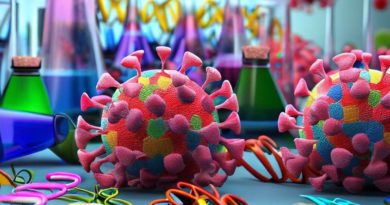#PlasmidGate: Plasmid DNA in Pfizer and Moderna injections can enter the nucleus of our cells in 5 different ways
Covid injections contain therapeutic levels of DNA – this is the definition of gene therapy.
When Pfizer and Moderna said that they produced an “RNA vaccine” and that an “RNA vaccine” meant that anything they injected into you would have a short-lived (days) effect at most, it was a lie.
When the media, the regulators and the government said it “isn’t gene therapy” without knowing what was actually in the product, that was also a lie.
To call the mRNA covid injections a “vaccine” is a lie. They are not vaccines they are gene therapy. This is the crux of Plasmidgate.
In addition to the declared mRNA, plasmid DNA has now been found in the mRNA injections by 6 laboratories. This DNA, and the RNA that is made from it, have special properties. Below, Dr. Ah Kahn Syed explains 5 different mechanisms for that DNA-RNA-protein combination to take that DNA into the nucleus of our cells.
Let’s not lose touch…Your Government and Big Tech are actively trying to censor the information reported by The Exposé to serve their own needs. Subscribe now to make sure you receive the latest uncensored news in your inbox…
By now I sincerely hope that you have all been watching the exposure of the #PlasmidGate scandal unfold on Twitter and various other platforms. If you haven’t, I’m going to summarise it for you as briefly as I can:
When Pfizer and Moderna said that they produced an “RNA vaccine” and that an “RNA vaccine” meant that anything they injected into you would have a short-lived (days) effect at most, it was a lie.
When the media, the regulators and the government said it “isn’t gene therapy” without knowing what was actually in the product, that was also a lie.
The primary reason that this is now proven to be a lie is that multiple laboratories around the world have proven that those covid vaccines contain therapeutic levels of plasmid DNA. DNA lasts forever and if it integrates into your genome, you will produce its product forever. There is no definition of gene therapy anywhere in the world that this process would be excluded from.
This is #PLASMIDGATE
For more details on #Plasmidgate outside of Twitter I would refer you to the original Substack from Kevin McKernan HERE and the whole testimony of Dr. Phillip Buckhaults HERE.
Note: Just for background, it’s important to know what plasmid DNA is – it’s the lab-based circular DNA particles that is replicated in big vats of poo and then used to create the mRNA that goes into your “short-lived” vaccine.
It’s a lab tool so should never be in a drug injected into a human. It’s not allowed to be there. It’s like having a drug that requires arsenic as a substrate to make it, and then throwing the leftover arsenic into the actual drug that gets injected into you.
But this article is not directly about the discovery of plasmid DNA in the Pfizer and Moderna injections (that has been now verified by 6 laboratories worldwide).
It’s about the special properties of the contents of that DNA and the RNA that is made from it, combined with the RNA that accompanies it (the injections have the stated RNA in them as well as the stowaway DNA).
You see, it turns out that there are at least 5 different mechanisms for that DNA-RNA-protein combination to take that DNA into the nucleus of your cells. And that wasn’t on the advertising brochure, was it?
Don’t believe me? See what Dr. Phillip Buckhaults has to say about the Buckshot. [The video below begins at] the most important part [of] his speech to the South Carolina (“SC”) Senate hearing and the most important bit of the most important bit is this:
During the process they chopped them [the DNA plasmids] up to try to make them go away but they actually increased the hazard of genome modification.
Wait, what?
They did something that increased the risk of genome modification?
Now why would they do that, surely that’s an accident.
And now we are here. Phillip quotes Hanlon’s razor, viz:

And I am going to show to you why the makers of the Pfizer and Moderna “mRNA vaccine” must be really, really, stupid if Hanlon’s Razor applies. It’s because in this one product there are at least 5 ways in which the product design and manufacture ended up with mechanisms that increase the risk of DNA going into the nucleus of your cells, thus modifying your genome.
In other words, if they wanted to skin this particular cat, they managed to find 5 separate ways to do it and throw them into the same product.
1: The Lipid Nanoparticles
I have addressed the lipid nanoparticles (“LNPs”) previously in THIS article from last year which has attracted 23,000 reads to date.
Note: The important point is that the LNP is a transfectant medium. The lipid acts as something that takes the nucleic acid product (DNA or RNA) into the cell and potentially onto the nucleus. That’s what transfection agents do.
Don’t take my word for it of course. Here 1 is the Pfizer-BioNTech official document that tells you that the product transfects cells and that the LNP is more effective than the commercially available transfection kit (Ribojuice™, which is designed for RNA rather than DNA).
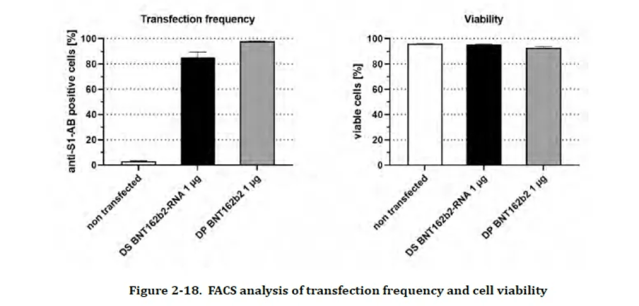
In other words, those lipid nanoparticles are designed to get DNA into the nucleus of cells, and do that job with both DNA and RNA better than a commercially available transfectant product.
When I say that the LNP (which are cationic) are intended to deliver DNA into the nucleus this is not some random claim. It’s well known. HERE from 2017:
It has been reported that DNAs delivered by Lipofectamine® 2000 reach the nucleus with a high frequency only after 4 h incubation.
What that means is that if the LNPs (or lipofectamine or any other cationic lipid particle) hang around for a few hours they will transfect (bring DNA into) the nucleus of any cell that it is in contact with.
And in the case of humans in which LNP-mRNA [2020] LNP-mRNA-DNA complexes are administered, thank God it doesn’t accumulate in the ovaries, right?
Yeah, about that. The LNP exceeds the 4 hours easily in the ovaries, and remember that the study stopped recording this data at 48 hours even though they claimed that the animals were monitored for up to 9 days.
And we knew that the distribution of LNPs to the ovaries was not only known about but was an intentional design back from a study in 2013 HERE. No “conspiracy theories” required. But I bet you didn’t see this mentioned in the consent form, did you? Check the date on this tweet:
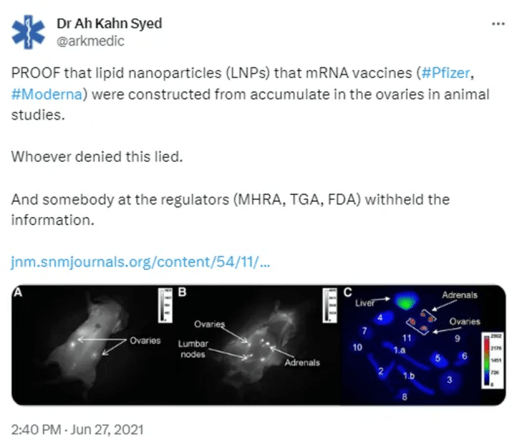
Now method one of skinning our cat is over, let’s move on to method two
2: Linearised plasmid DNA
So, what on earth is that I hear you say? Let’s break it down: Linearised – Plasmid – DNA.
Well DNA is what shouldn’t be in the product. It’s not RNA (which is the stuff that is meant to last for a few minutes and then get degraded, but that’s not what this article is about). It’s the nucleic acid type that makes up your genome, the stuff that is the blueprint for you. RNA is derived from DNA and makes the proteins that enable you to live.
This is called the “Central Dogma of Molecular Biology.”
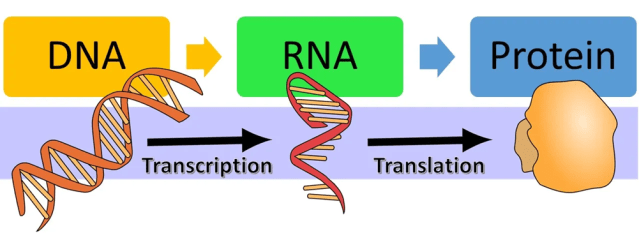
The bottom line being that, in general, if you want to have an effect on an organism (e.g., a person) using genetic methods, you can do this temporarily with RNA – which will then produce protein and should then degrade so it doesn’t produce any more. But if you want to make it more permanent you would use DNA and integrate it into the genome. Then when called on it will produce RNA which will produce protein. That process could happen for ever under the right circumstances.
The step for RNA to produce protein usually happens immediately when RNA is produced (or introduced) in the cell. But for DNA to enact this process (to induce transcription and then translation) requires the DNA to have a signal to act. This is usually from a promoter which can respond to local signals and start the transcription process (it needs to be regulated so that it is not switched on all the time).
There are multiple mechanisms for the regulations of RNA transcription and the elements that regulate (increase, decrease, start, stop) transcription don’t even need to be in the same area of the gene being regulated. It’s a complex process that we don’t know everything about for every gene.
The point is that, if foreign DNA gets into your genome all hell can break loose – the most notable risk being cancer. This is because cancer is, in general, a situation where the control of cell growth and replication is disturbed. And cell growth and replication is a tightly controlled and complex system so any disturbance of it is either going to make cells grow more or less. Growing more cells without control is what gives you cancer. And this is known about in the field of gene therapy (where nucleic acid material is introduced to a person in order to correct a deficiency) such that one of the first gene therapies was stopped for this reason.
This is “insertional oncogenesis” where cancer is caused by the insertion of additional fragments of DNA into areas of the DNA that interrupted the regulation mechanisms of that DNA.
Read more: Insertional oncogenesis in gene therapy: how much of a risk? Gene Therapy, 18 March 2004
In fact, all you need to create a cancer risk in a cell is for there to be enough “buckshot” (the term used by Phillip Buckhaults) for one of the pellets to stick itself where it doesn’t belong. And the more “buckshot” you have the higher the chance. When it comes to this particular buckshot, we are talking about billions of copies of random DNA fragments. That’s a problem as discussed also here: Sequencing of bivalent Moderna and Pfizer mRNA vaccines reveals nanogram to microgram quantities of expression vector dsDNA per dose, OSF Preprints.
And here: Sequencing of bivalent Moderna and Pfizer mRNA vaccines reveals nanogram to microgram quantities of expression vector dsDNA per dose, Anandamide, 11 April 2023
And here: With Large Numbers, Low Probability Becomes Guaranteed, The Daily Beagle, 28 September 2023
So that is the “DNA” bit but what about the other bits – “Linearised Plasmid.”
Well, the plasmid is the circular loop of DNA that is used to transfect the E.Coli – the bacteria that make up the biggest constituent of poo. This is what a diagram of it looks like (actually, this is what Kevin McKernan found on sequencing because the original diagram from Pfizer had a lot of components hidden):
This form of DNA is very good at getting into bacteria and getting them to produce what you need, which is the process that was used in “Process 2” of the Pfizer vaccine production. That is the one that was rolled out to the world – now designated #Poojabs because of the way it was produced. This was not explicitly declared to the public, by the way, and required the infamous Freedom of Information law suit to uncover as published by Josh Guetzkow HERE.
However, plasmid DNA is not normally that dangerous to humans because it is readily destroyed by circulating enzymes. The problem comes when the plasmid DNA is encapsulated in a lipid nanoparticle. Then it doesn’t get destroyed and whichever organism it gets injected into may react in a similar way to the #poojabs bacteria it was intended for. The mere presence of this lab-tool in a medicinal product for which it was not intended is therefore a regulatory no-no for this and other reasons as outlined in the EMA guidelines HERE.
So, having lab-plasmid DNA intended for bacteria (which includes antibiotic resistance genes that you really don’t want injected into you) contaminating your “RNA therapy” is shocking enough, but what is Phillip saying about the small fragments?
Well, he says “little bitty lines” and that what he found was small fragments of DNA from the plasmid that they “tried to chop up” with enzymes. But it didn’t remove the lab-tool DNA at all, merely chopped it into little pieces. And do you know what happens when you chop a circular plasmid DNA into little pieces? It’s not circular anymore. It’s linear and that’s a problem.
In fact it’s such a problem that THIS publication below shows that whatever they tried to do to the ends of linear DNA fragments they couldn’t stop them integrating into the genome with 10-20% of fragments (remember there are billions of them) integrating.
Read more: High spontaneous integration rates of end-modified linear DNAs upon mammalian cell transfection, Scientific Reports, 26 April 2023
You can see from the graphic that simply linearising the plasmid (red → orange) significantly increases the amount of stable transfection (incorporation into the genome).
So, that’s what Phillip and Kevin are talking about. Breaking the plasmid up into linear fragments doesn’t destroy it. It makes it more likely to integrate into the genome.
If that was what you were trying to do, it would be a nice backup way to skin your cat. But we’re not finished yet…
3: The SV40 enhancer
One of the most shocking discoveries from Kevin McKernan’s sequencing analysis of the Pfizer vaccine was the inclusion of fragments of the SV40 promoter/enhancer.
What’s that you ask?
Well, SV40 is a monkey virus (Simian Virus hence “SV”) that is infamous for two things:
- it’s highly oncogenic because of its enhancer/promoter region; and,
- it got into polio vaccines in the 50s and because it was so dangerous the regulators are still looking for it in vaccines.
Read more: Polio vaccine & SV40 contamination, Therapeutic Goods Administration, Australian Government, 14 Decemeber 2004
A gene enhancer is a switch that ramps up the production of gene product (protein) that it is affiliated with. In the case of SV40, the enhancer will essentially turn a gene on and never switch it off. The virus itself has its own T-antigen protein that is produced in buckets due to the enhancer region, and this protein causes cells to divide in an uncontrolled fashion (hence cancer). The enhancer region therefore is popular for genomic scientists who want to get cells to produce proteins in large quantities, because it can be placed next to a gene of interest and it will be switched on permanently. Hence why it’s a lab tool.
Note: That’s a problem if it were to get into the human medicinal chain because if that promoter gets into the genome next to a cancer gene you’re going to be in big trouble, potentially causing a “turbo cancer” which is a term that has appeared recently.
The sequence map below shows that this wasn’t random with both versions containing the enhancer and …
In the sequence map above, you can see in the blue boxes (and pointed out by the authors) that there is one copy of a 72bp (base pair, or nucleotide pair) element in one version and two copies in another. This is 72bp element is directly from the SV40 genome and is seen in the enhancer of SV40 in either one of two copies.3 It’s not a random 72bp sequence.
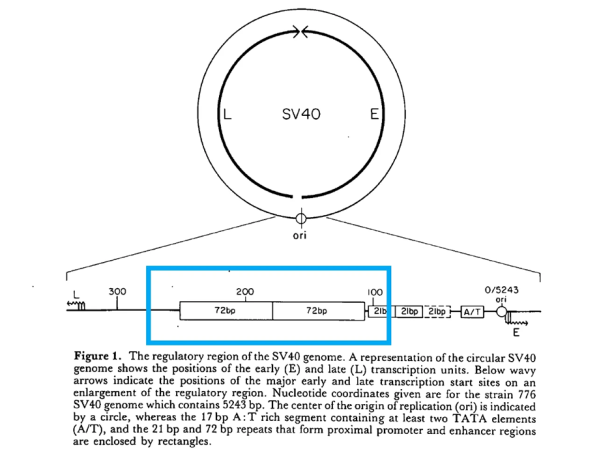
Therefore, the inclusion of the SV40 enhancer region was deliberate and it should not have been anywhere near a product intended for human use.
But remember this article is about one thing – elements of the vaccine properties that appear to increase the chance of DNA getting into the nucleus. The SV40 enhancer is dangerous because it can cause cancer or other problems if it gets into the human genome, but it has one other peculiar property.
The SV40 enhancer region of the SV40 genome is a DNA nuclear targeting sequence (DTS or NTS)
This is known from decades of work by David Dean of University of Rochester who was kind enough to discuss some of this with the Daily Beagle for their article here: ‘Exclusive: Plasmids Can Integrate Without Transfectants’.
But to drive the point home, Dean showed conclusively that the 72bp sequence from that SV40 enhancer region was required in order to transport plasmid DNA (or any introduced DNA, for that matter) into the nucleus of cells (other than those undergoing cell division).
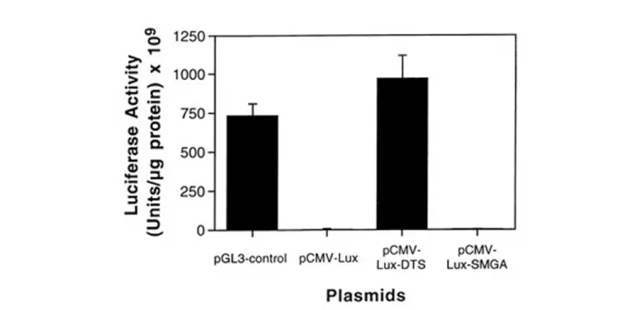
So, not only did the people that made this product not seem to care whether there was a cancer-causing SV40 enhancer sequence injected into recipients, but that sequence was coincidentally the only one that could have been chosen that had a specific property of facilitating the transport of any foreign DNA that happened to be present into the nucleus.
Cat skinning method number three complete, but the story is not over.
4. Spike protein nuclear localisation signal
Now this one is much easier.
Essentially, the spike protein (not the RNA or DNA) contains a special peptide sequence which acts as a nuclear transporter of any DNA that is attached to it. It’s one of many mechanisms for nuclear transport (that is, carriage of DNA into the nucleus) elucidated in this seminal review from the same David Dean HERE.
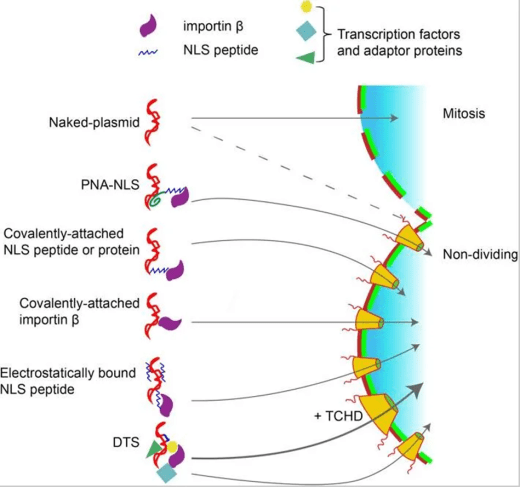
The common theme is that the DNA needs a nuclear localisation helper, which can be a Nuclear Localisation Signal (NLS, a specific sequence of amino acids in a protein in the cell) or a DNA transport sequence (DTS, discussed above in the SV40 section). By the way this only applies to cells that are not dividing. In cells that are dividing (undergoing mitosis) you don’t need any of these fancy mechanisms as shown in the graphic above – any free-floating DNA will simply integrate.
So, thankfully there are no proteins floating around with a Nuclear Localisation Sequence accompanying the Pfizer or Moderna (or Novavax) “vaccines”, right?
Wrong. Here’s the paper: ‘Nuclear translocation of spike mRNA and protein is a novel feature of SARS-CoV-2’.
There are two interesting things about this massively important discovery:
- That there is a nuclear localisation signal (“NLS”) in the spike protein at all. It should have been removed when they “created the vaccine in record time.”
- The nuclear localisation signal (“NLS”) is the sequence PRRARSV. It’s the same sequence as the furin cleavage site.
Now I’ll need to take you back a little bit to December 2021. Remember this?
Read more: How to BLAST your way to the truth about the origins of Covid-19, Dr. Ah Kahn Syed, 28 December 2021
That article paved the way for the publication of THIS paper confirming that the furin cleavage site of the SARS-CoV-2 virus was derived from a Moderna patented gene sequence.
In fact, Moderna have never got round to denying this – or that they had never created a working product and suddenly won the pharma lottery. Here’s the train wreck interview (archived):
Now here’s the kicker. The furin cleavage site, that was touted as the scary insertion that caused virulence of the scary virus – was kept in the vaccine sequence.
That’s right. The highly toxic and inflammatory amino acid sequence QTNSPRRARSV, that was supposed to be one of the reasons for the “cytokine storm” (that was later found to be fake), was retained in the “vaccine” design. This is not normal in vaccine design and in fact the Spikogen vaccine removed this inflammatory fragment from its design, as it should.
So, why would vaccine manufacturers (other than for Spikogen) keep this component in? Well, obviously it has nothing to do with the fact that the furin cleavage site contains this sequence: PRRARSV
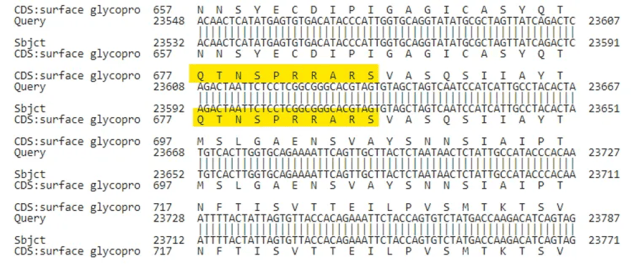
Which is exactly the same sequence as documented in the Sattar paper above and is a nuclear localisation sequence (“NLS”).
Note: In other words, the retention of the “furin cleavage site” part of the spike protein – which is highly inflammatory and should not have been kept in the design of a vaccine – rendered an additional method by which any fragments of DNA that were present could be transported to the nucleus and integrated into the genome.
What a coincidence!
Imagine incorporating something that the industry knew was dangerous into an RNA vaccine “not knowing” that this very thing would make any “contaminant” DNA get into the nucleus.
How unlucky do these researchers have to be?
Well, planned or not, that gives us the fourth way that our genetically modified cat could be skinned.
But four isn’t enough, is it? I mean, if you really, really wanted to make sure that DNA could get integrated into the genome and you couldn’t guarantee that people would line up for repeated doses; you’d need a fifth option to guarantee that the product could integrate.
5. Open Reading Frame in the PolyA tail
Okay, I have to admit that now we’re in speculation territory. But there are just too many coincidences.
The “poly-A tail” is the end cap on an mRNA sequence. It’s like the bottle cap on a bottle of fizzy pop. Without it, the pop will taste of something but it won’t have any fizz. The poly-A tail is a run of adenosines (AAAAAAA’s) added to the end of an RNA sequence and it serves to protect it from degradation as well as to allow export from the nucleus where it would be normally produced (from DNA) in a mammalian cell.
Sounds fine, right?
But there is something not quite right with the poly-A tail in the Pfizer vaccine sequence, and no explanation for it that I have been able to find. Here it is:


And what is weird about it is that the middle bit GCATATGACT has a sequence that contains a “start codon,” that is a triplet that tells the ribosome to start translating from RNA to a protein. There is no logic for it to be there. Now we can put this sequence into a protein translator program and get this:
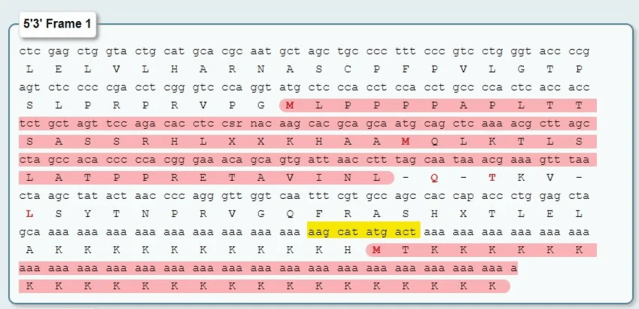
The tool tells us what will translate (in pink) and which requires a “M” (Methionine) to start any protein. The code for “M” here is ATG which is in that poly-A tail sequence (but shouldn’t be).
Note: So, theoretically, if that sequence (or even the one before it) were to “read through” the stop codons ahead of it, or if that fragment separated (because the plasmid was chopped up into pieces), there is a possibility of producing a poly-K sequence peptide. And that is a very highly charged sequence which could carry anything into the nucleus.
Of course, that couldn’t happen because “stop codon read through” – where the normal signals to stop translating a protein when a “stop codon” is encountered is ignored and translation keeps going – can’t happen, can it? And it certainly couldn’t translate the poly-A tail in the “untranslated region (UTR)” could it?
Well, it could under certain circumstances. One of those circumstances would occur if, instead of using standard RNA (containing uracil), the designers used “pseudouridine” (a synthetic version of uracil). Which is precisely what happened in the case of the Pfizer and Moderna “mRNA vaccines”. Pseudouridine is known to carry a risk of precisely this event happening.
And, again totally coincidentally, Pfizer and Moderna presumably knew about this problem because instead of just one stop codon (the termination code for RNA translation) in the RNA sequence, Pfizer had two and Moderna had three. Which is like putting an extra set of brakes on your car because you knew that the first set would fail.
The very existence of these at least allows us to drop one of our favourite geeky memes:
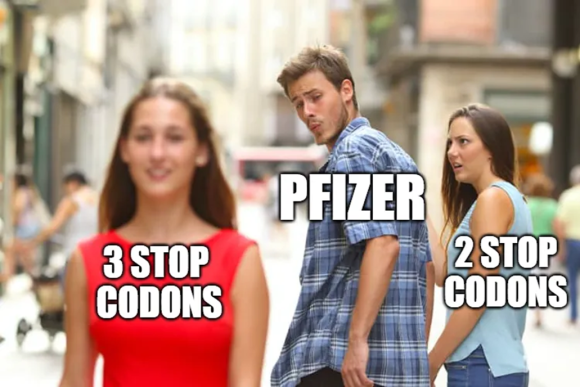
Summary
I’ve come to the end of this little trip around the “mRNA” covid injection sequences and their intentional absolutely coincidental properties that make transfer of their plasmid DNA into the genome highly likely. And of course, this is dose dependent so the more doses you have the more likely the plasmid fragments will be to integrate into your genomic DNA.
Fortunately, they thought about all this when they rolled out the therapy and they also thought about the impact in gametes (sperm and egg cells) which would pass on that signal to the next generation.
And on that note I will leave you with an excellent graphic from an anoymous(e) Twitter account which should give you an idea of the scale of the problem that we could be dealing with in terms of heritability of these DNA fragments.
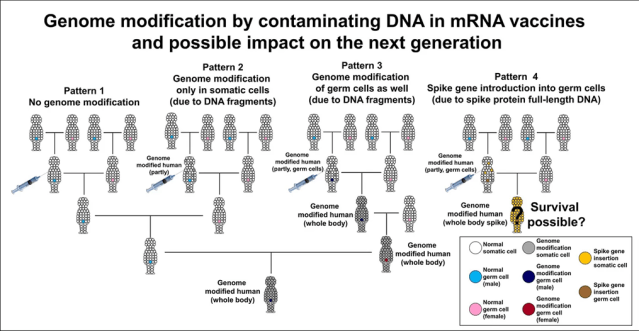
Fortunately, we are protected by our drug regulators, who knew all this when they approved these drugs.
They did, didn’t they?
References:
- 1 The terms used in this and linked article will be context dependent. A “transfection agent”, “transfectant agent” or “transfection reagent” is the product that is used to help transfect cells. The resulting cells are transfectants (or transfected cells).
- 2 TGA FOI 2389 document 6 (reduced redaction version) HERE (download pdf).
- 3 Herr, W. The SV40 enhancer: transcriptional regulation through a hierarchy of combinatorial interactions. Seminars in Virology (4) 1993:3-13. HERE (download pdf). The genomic sequence of the 72bp region is
atggt tgctgactaa ttgagatgca tgctttgcat acttctgcct gctggggagc ctggggactt tccacac, matching the sequence in Kevin’s analysis below:
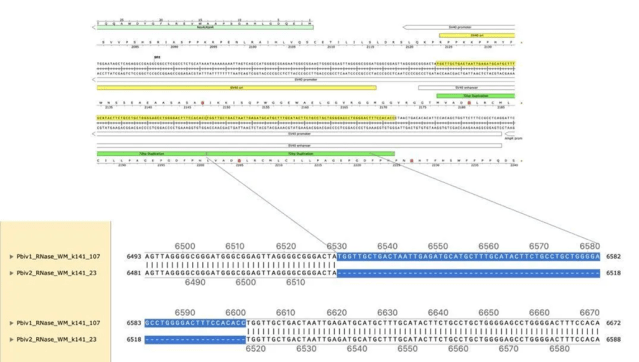
About the Author
Dr. Ah Kahn Syed is a pseudonym for a medical whistle-blower who is both a medical doctor and a PhD. The only clue his/her identity the whistle-blower provides is that he/she is on the “Francesoir list.”
Dr. Ah Kahn Syed was previously known as Arkmedic on Twitter and has a channel on Telegram titled ‘Arkmedic’s feed’. The “not anti-vax, just pro-truth” doctor has a Substack page titled ‘Arkmedic’s Blog’ which you can subscribe to and follow HERE.

This article has been archived for your research. The original version from The Exposé can be found here.

